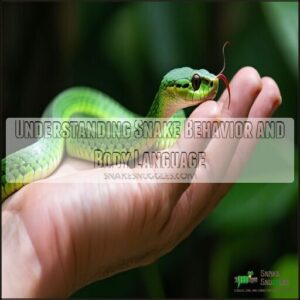This site is supported by our readers. We may earn a commission, at no cost to you, if you purchase through links.

Corn snakes and ball pythons are top picks for beginners, offering gentle temperaments and manageable sizes. You’ll need to create a habitat that mimics their natural environment, complete with proper heating, humidity, and hiding spots.
Feeding is straightforward—most pet snakes eat pre-killed mice and require meals only every few weeks. With the right care, your scaly friend can live up to 20 years. Ready to unravel the secrets of snake ownership?
Table Of Contents
- Key Takeaways
- Choosing The Perfect Pet Snake
- What Makes a Good Pet Snake
- Popular Pet Snake Breeds for Beginners
- Understanding Snake Behavior and Body Language
- Creating a Suitable Environment for Pet Snakes
- Feeding and Nutrition for Pet Snakes
- Health and Hygiene for Pet Snakes
- Handling and Restraint Techniques for Pet Snakes
- Advanced Pet Snake Care and Considerations
- Bringing a Pet Snake Home and Beyond
- Frequently Asked Questions (FAQs)
- What are some things to consider before getting a pet snake?
- What kind of pet snakes are there?
- Where can I find live pet snakes for sale?
- What is the most pet friendly snake?
- What is the most cuddly pet snake?
- What is the most low maintenance snake?
- Which pet snake is least likely to bite?
- What is the best pet snake to own?
- Are pet snakes affectionate?
- Do any snakes like being handled?
- Conclusion
Key Takeaways
- You’ll want to choose your first pet snake carefully, with corn snakes and ball pythons being ideal for beginners due to their gentle temperament and manageable size.
- You’ll need to create a precise habitat that mimics your snake’s natural environment, including proper temperature gradients, humidity levels, and hiding spots to ensure your pet’s health and comfort.
- You’ll have to master proper handling techniques, learning to read your snake’s body language and building trust through consistent, calm interactions that respect their unique personality and stress signals.
- You’ll be committing to a long-term relationship, as many pet snakes can live 20-30 years with proper care, requiring ongoing education, veterinary check-ups, and a consistent investment in their nutrition and well-being.
Choosing The Perfect Pet Snake
Choosing the right pet snake can be an exciting adventure for first-time reptile owners looking to start their slithery companionship journey.
With the right research, temperament match, and care knowledge, you’ll find a scaly friend that’ll make an incredible addition to your home, and have a wonderful companionship.
Factors to Consider for Beginners
Wondering if a slithery companion is right for you?
Slither into snake ownership with confidence! Your perfect scaly friend awaits, ready to transform your reptile adventure.
Explore snake ownership with confidence! Here are key considerations for aspiring reptile parents:
- Snake Size: Match your living space to your potential pet’s growth potential.
- Budget Basics: Factor in ongoing care costs beyond the initial purchase.
- Temperament Check: Select docile breeds that mesh with your handling comfort level.
Your perfect snake adventure starts here!
Popular Pet Snake Options for Starters
Explore the realm of docile snakes perfect for beginner snake owners.
Your first pet snake journey starts here with top-tier companions that’ll make reptile parenting a breeze.
Ball pythons and corn snakes top the list for their gentle temperament and easy handling.
The California kingsnake and rosy boa join this beginner-friendly lineup, offering manageable sizes and calm personalities.
Each breed brings unique charm, ensuring you’ll find your perfect scaly sidekick with confidence and excitement.
Unique and Interesting Pet Snakes for Experts
Ready to graduate from beginner snake keeper?
Snake experts and collectors craving uniqueness will love these rare morphs and specialized breeds. The Western Hognose brings drama with its venomous mimicry and bluffing skills, while the Woma Python offers an exotic arboreal setup that’ll turn heads.
For the true snake showstopper, consider these standout options:
- Western Hognose – nature’s theatrical performer
- Woma Python – a burrowing beauty with attitude
- Bamboo Rat Snake – the collector’s dream specimen
Your advanced reptile journey starts now!
What Makes a Good Pet Snake
You’re about to discover the secret to selecting the perfect pet snake that’ll match your lifestyle and personality.
Whether you’re a first-time snake owner or a reptile enthusiast, understanding key traits like temperament, size, care requirements, and longevity will help you choose a scaly companion.
That’ll slither right into your heart, with a deep understanding of these traits being crucial for a harmonious relationship between you and your pet snake, considering factors such as lifestyle.
Temperament and Handling Considerations
When choosing a pet snake, understanding their temperament is your golden ticket to a smooth relationship.
- Snakes speak volumes through body language – learn their silent signals for a harmonious reptilian friendship.
Each snake’s personality is as unique as a fingerprint—some are zen masters, others might get their scales in a twist when stressed.
Corn snakes, for instance, are the cool cats of the snake world, perfect for beginners mastering snake handling.
Read their body language like a pro: relaxed movements mean you’re doing great, while coiling or hissing signals it’s time to back off.
Gentle, frequent handling builds trust, but always respect their personal space.
Remember, snake handling isn’t about domination—it’s about connection.
Regular handling can improve a snake’s overall temperament and handling.
Husbandry and Care Requirements
After mastering handling basics, your snake’s home becomes your next priority.
A well-designed habitat isn’t just shelter—it’s survival central for your scaly friend.
Here’s your snake care blueprint:
- Pick an enclosure matching your snake’s adult size
- Create temperature zones with warm and cool areas
- Maintain humidity between 50-70% for healthy shedding
- Choose substrate that mimics natural environment
Your commitment transforms a simple space into a snake sanctuary, which is crucial for healthy shedding.
Longevity and Lifespan Expectations
Want to know how long your scaly friend might stick around? Snake longevity isn’t a game of chance—it’s a science of care.
Different species bring unique lifespans to the terrarium:
- Ball pythons can rock 20-30 years with exceptional care
- Corn snakes stretch past two decades when pampered
- Environmental conditions dramatically impact snake health
- Genetics play a silent role in potential lifespan
- Record-holding snakes prove extraordinary pet snake longevity
Your commitment determines their journey. While wild snakes face shorter lives, captive pets enjoy controlled environments that can extend their years.
Proper husbandry, consistent nutrition, and attentive healthcare transform your pet snake’s potential from mere survival to thriving companionship.
Popular Pet Snake Breeds for Beginners
If you’re new to snake ownership, choosing the right pet snake can feel like traversing a reptilian maze.
Whether you’re drawn to the corn snake’s docile nature, the ball python’s manageable size, or the California kingsnake’s striking colors, these beginner-friendly breeds offer a perfect introduction to the fascinating world of pet snakes, with the ball python being a notable example.
Corn Snake Characteristics and Care
Your journey into snake ownership kicks off with the corn snake—a beginner’s best friend in the reptile world.
These docile serpents boast stunning cornsnake morphs that’ll catch every eye in the room.
With a gentle temperament and manageable size, they’re perfect for first-time snake parents.
Maintain their enclosure at 65-75% humidity, feed pre-killed mice, and watch them thrive.
Handling them regularly builds trust and helps you understand their unique snake temperament.
Master their care, and you’ll have a scaled companion that can slither into your heart for 10-20 amazing years.
Ball Python as a Beginner Pet
Some snake enthusiasts find their perfect companion in ball pythons. These docile reptile pets charm beginners with their manageable 3-5 foot size and calm demeanor.
Your new snake friend requires a cozy habitat between 75-90°F, thriving on frozen-thawed rodents.
With countless color morphs available, ball pythons offer snake beginners an exciting, low-maintenance entry into snake keeping.
California King Snake Temperament and Care
The California kingsnake reigns supreme as a beginner-friendly reptile companion, offering vibrant patterns and an easygoing nature that’ll win your heart.
These curious explorers adapt quickly to gentle handling and thrive with proper care.
- Master kingsnake handling techniques for stress-free interactions
- Create enclosure enrichment with strategic hiding spots
- Maintain consistent temperature gradients (85-90°F warm zone)
- Provide diet variety with frozen-thawed rodents weekly
With scrupulous attention to their habitat and needs, you’ll transform your California kingsnake into a confident, healthy pet that’ll slither right into your affections.
They need a substrate like aspen so they can have proper burrowing habits, which is essential for their overall well-being and allows them to exhibit natural behavior in a healthy environment.
Understanding Snake Behavior and Body Language
Learning to read your snake’s behavior helps you understand its needs and keep it comfortable.
From subtle tongue flicks to defensive postures, their body language can tell you a lot—once you know what to look for.
Recognizing Stress and Aggression Signs
Reading your snake’s mood is like deciphering a secret code—it’s all in their body language.
Stress or aggression can show up through defensive postures or erratic movements.
Watch for these signs:
- Hissing sounds paired with an S-shaped coil (classic snake defensive behavior).
- Appetite changes, like skipping meals without reason.
- Rapid tongue flicking or constant pacing in their enclosure.
If your snake seems defensive during handling sessions, it’s a red flag.
Early detection of stress or snake aggression can prevent strikes and keep your pet happy.
Understanding snake behavior isn’t just helpful—it’s the key to a smooth, stress-free bond with your slithery friend.
Promoting Social Interaction and Handling
Safe socialization with your snake starts with patience and positive reinforcement.
Use slow, steady movements and handle them gently to build trust. Keep initial sessions short, gradually increasing handling frequency as your snake becomes comfortable.
Pay attention to their behavior—reading cues like tongue flicks or body tension helps prevent stress.
Consistent, calm interaction strengthens your bond, turning snake handling into a stress-free, rewarding experience for both of you.
Identifying Unique Personalities and Breed Features
Every snake has a personality worth discovering.
Ball pythons enjoy solitude, while corn snakes act like curious explorers.
Hognose snakes? They’re the drama queens, playing dead with flair.
Pay attention to breed temperament, unique markings, size variation, and feeding quirks.
These snake unique traits—like a species’ activity levels or vibrant coloration—help you connect with their individuality and appreciate their fascinating world.
Creating a Suitable Environment for Pet Snakes
Creating the right habitat for your snake isn’t just important—it’s essential for their health and happiness.
You’ll need to balance temperature, lighting, humidity, and space to mimic their natural environment.
Setting Up The Perfect Enclosure
A well-thought-out snake enclosure guarantees your pet feels safe and happy.
Follow this checklist:
- Enclosure Size: Choose a terrarium roomy enough for natural movement.
- Substrate Choice: Use aspen shavings, coconut husk, or newspaper for ideal snake bedding.
- Hiding Spots: Add caves or logs to create cozy retreats.
- Water Source: Include a sturdy bowl for hydration and soaking.
Design your snake terrarium thoughtfully—it’s their forever home!
Selecting the correct terrarium size is vital for their well-being.
Heating and Lighting Requirements
Creating the right heat and light setup is key to your snake’s comfort.
Use snake heat lamps or ceramic heaters to establish basking temperatures on one side of the enclosure, leaving the other cooler to form a proper heat gradient.
Under-tank heating pads work well for belly warmth but need thermostats to prevent burns.
While UVB lighting isn’t a must for every species, it benefits some snakes’ health.
Stick to natural light cycles—12 hours on, 12 off—and avoid disrupting night temperatures with bright bulbs.
Always monitor snake temperature requirements with digital thermometers to keep their environment safe and cozy.
A vital aspect is maintaining proper humidity using a digital probe hygrometer.
Humidity and Substrate Considerations
The snake’s habitat is a delicate ecosystem, where humidity plays a vital role in its health and comfort. Your reptilian friend depends on the right moisture levels to thrive.
Choose your substrate wisely to create the perfect environment:
- Match substrate to your snake’s native habitat
- Prevent shedding issues with proper humidity control
- Monitor moisture levels using a reliable gauge
- Avoid materials that can cause mold or respiratory problems
Different snake species demand unique substrate types, so research is key to keeping your scaly companion happy and healthy. Selecting the right snake bedding options is essential for their well-being.
Feeding and Nutrition for Pet Snakes
As a new snake owner, you’ll need to master the art of feeding your slithery companion with precision and care.
Your snake’s diet isn’t just about tossing in a mouse; it’s a critical aspect of nutrition that requires understanding each breed’s unique dietary needs.
Developing a consistent feeding schedule that guarantees your pet’s health and well-being is essential, as it directly impacts the well-being of your snake.
Choosing The Right Food for Your Snake
In the sphere of pet snake diets, choosing the right food can make or break your reptilian companion’s health. Your slithery friend’s menu depends on size, species, and individual preferences.
Check out this quick prey guide:
| Snake Size | Prey Type | Frequency | Preparation | Notes |
|---|---|---|---|---|
| Small | Pinkie mice | Weekly | Frozen-thawed | Easiest option |
| Medium | Adult mice | Bi-weekly | Thawed carefully | Most common |
| Large | Rats | Monthly | Room temperature | Requires careful handling |
Whole-prey feeding guarantees balanced nutrition and mimics natural hunting behaviors. Many owners prefer to buy frozen rodents for convenience.
Pro tip: Always match prey size to your snake’s widest body point for smooth digestion, ensuring a healthy and thriving pet.
Feeding Techniques and Schedules
After mastering prey selection, you’ll want to nail your snake’s feeding rhythm.
Here’s your game plan:
- Match prey size to your snake’s widest body section—no larger.
- Juveniles feast weekly; adults enjoy bi-weekly meals.
- Choose frozen prey to minimize injury risks and optimize nutrition.
Pro tip: Watch your serpent’s body language during feeding for perfect portion control.
Supplements and Vitamins for Optimal Health
After nailing your snake’s feeding routine, boost its health with smart supplementation.
Sprinkle calcium and Vitamin D3 on prey to fortify bones and support smooth shedding.
Think of multivitamins as your reptile’s health insurance—preventing deficiency symptoms and minimizing vet visits.
A balanced supplement schedule keeps your slithery friend thriving, transforming basic snake care into pro-level reptile parenting, with a focus on overall well-being.
Health and Hygiene for Pet Snakes
You’ll want to stay on top of your snake’s health to guarantee it thrives in captivity, which means understanding common ailments and maintaining a pristine enclosure.
Proper hygiene isn’t just about cleanliness—it’s your first line of defense against potential health issues that could compromise your slithery companion’s well-being.
Common Health Issues and Prevention
Addressing health challenges, your pet snake’s wellness hinges on proactive care and keen observation.
Watch for these telltale signs of potential issues:
- Parasites: Detect mites early through regular veterinary check-ups
- Respiratory Infections: Monitor breathing and prevent stress-induced complications
- Shedding Difficulties: Maintain ideal humidity to facilitate smooth scale transformations
Stay vigilant, and you’ll keep your slithery companion healthy and thriving!
Cleaning and Maintenance of The Enclosure
Your snake’s habitat demands routine TLC.
After monitoring health issues, shift gears to maintaining a pristine enclosure. Spot-clean waste daily, replace snake substrate weekly, and sanitize surfaces thoroughly.
Use specialized snake enclosure cleaners to prevent mold and control odors. Wipe down hides and decor carefully.
Remember: a clean environment means a happy, healthy snake. Proper enclosure sanitization isn’t just about looks—it’s about creating a safe, comfortable home for your slithery friend.
Quarantine and Isolation Procedures
When welcoming a new snake, initial quarantine becomes your first line of defense against potential health issues.
Here’s your game plan for safe snake integration:
- Enforce a strict 30-day isolation period to monitor for snake diseases
- Disinfect all handling tools and maintain impeccable hygiene
- Watch closely for stress signals and unusual symptoms that could indicate underlying health problems
Handling and Restraint Techniques for Pet Snakes
You’ll want to master the art of handling your pet snake with confidence and care, ensuring both your safety and your snake’s comfort.
By learning proper support techniques, restraint methods, and trust-building strategies, you’ll transform your initial nervousness into a smooth, enjoyable interaction.
This interaction will strengthen your bond with your scaly companion.
Safe Handling and Support Methods
The art of safe snake handling begins with mastering gentle, confident support.
Always use both hands, cradling your snake’s body without constricting its movement. Keep your grip steady but relaxed, like holding a fragile treasure.
Watch for signs of stress and move slowly to build trust. Handling tools can help novices feel more secure, but most beginner-friendly snakes respond best to calm, predictable touch.
By understanding snake body language and practicing smooth, deliberate movements, you’ll minimize snake bites and reduce handling anxiety.
Restraint Techniques for Veterinary Visits
When it’s time for your slithery friend’s medical checkup, smart preparation makes all the difference. Your vet visit success hinges on strategic snake handling tips that minimize stress and maximize safety.
- Choose a secure, well-ventilated carrier designed specifically for reptile transport.
Professionals recommend using snake hooks for controlled movement, reducing the risk of sudden escapes or snake bites. Before arriving, brief your veterinarian about your pet’s unique temperament and any specific handling quirks.
Avoid attempting restraint immediately after feeding or during shedding periods, as these are high-stress times for reptiles. Remain calm, confident, and gentle—your snake will pick up on your energy during these critical moments.
Building Trust and Confidence With Your Snake
After mastering veterinary restraint techniques, your next challenge is building a bond with your slithery companion.
Gradual, safe handling is key to snake socialization. Start with short, consistent interactions in a calm environment.
Read your snake’s signals—relaxed movements and steady tongue flicks indicate comfort. Use positive reinforcement by offering gentle support and predictable routines.
Remember, snake handling tips aren’t about forcing connection, but creating trust through patience and understanding. Your reptilian friend will appreciate your measured approach.
Advanced Pet Snake Care and Considerations
You’re ready to level up your snake-keeping skills and tackle more advanced care techniques that go beyond basic husbandry.
As you explore larger snake species and long-term commitments, you’ll discover the intricate world of snake training, socialization, and specialized needs.
That make reptile ownership both challenging and incredibly rewarding.
Larger Snakes and Their Special Needs
When diving into large snake species, design an enclosure that’s at least twice the snake’s length for ideal comfort and safety.
Your snake habitat should prioritize these key elements:
- Sturdy, escape-proof terrarium with secure locks
- Precise temperature gradient matching specific snake species needs
- Ample climbing branches for mental stimulation
- Humidity-controlled environment mimicking natural habitat
Feeding larger snakes requires bigger prey and longer digestion periods.
Always handle with caution, involving two people for maximum safety when managing substantial snake species.
Owners should also research required permits overview before acquiring certain species, ensuring they understand the specific needs of their pet and the importance of a secure environment.
Long-Term Commitment and Responsibility
Frequently, snake ownership is more than a fleeting fascination—it’s a profound commitment.
Your snake might share your life for up to 30 years, demanding consistent financial investment in veterinary care, specialized nutrition, and habitat maintenance.
Ethical snake ownership requires ongoing education, careful future planning, and understanding the true responsibility of nurturing a living creature.
You’ll adapt your lifestyle, budget, and living space to guarantee your snake’s health, happiness, and well-being throughout its entire lifespan.
Potential Training and Socialization Opportunities
After investing time in your long-term snake care journey, you’ll want to discover the potential of snake training and socialization.
Enrichment activities aren’t about teaching tricks, but building trust through smart interaction strategies:
- Positive Reinforcement: Create consistent handling sessions that help your snake associate human contact with safety and comfort.
- Behavioral Cues: Learn to recognize and interpret your snake’s unique personality through environmental complexity and careful observation.
- Interaction Techniques: Develop gentle approaches that respect your snake’s natural instincts while gradually expanding their comfort zone.
Snake socialization is an art of patience and understanding!
Bringing a Pet Snake Home and Beyond
You’re about to venture on an exciting journey into snake ownership, where careful preparation meets the thrill of welcoming a scaly companion.
Before bringing your new snake home, you’ll need to create a secure, comfortable habitat and understand the essential care techniques that’ll help your slithery friend thrive.
Preparing for The New Arrival
Ready to welcome a slithery friend? Your snake’s first home needs laser-focused preparation. Think of it like prepping a VIP suite for a guest who might try to escape!
- Check every inch of the enclosure for potential breakout routes
- Stock up on reptile supplies before arrival day
- Verify temperature gradients are spot-on
Set up a cozy quarantine setup with precise heat sources and humidity control. Test your snake heat source a week early to avoid temperature surprises.
Label frozen food containers, keep extra heating bulbs handy, and make the enclosure easily accessible for cleaning. First impressions matter—even for your cold-blooded companion!
Acclimating Your Snake to Its New Environment
After carefully setting up your snake’s new home, it’s time to help them settle in.
Your first mission is to minimize snake stress by creating a calm, quiet sanctuary. Place the enclosure in a low-traffic area and resist the urge to handle your new scaly friend for at least a week.
Set precise temperature and humidity levels, and strategically position multiple hides—one in the warm zone, another in the cool side.
Watch for subtle signs of comfort: slow exploration, relaxed posture, and eventually, a hearty first meal, which indicates a successful Initial Setup. Patience is your greatest ally in this delicate process.
Ongoing Care and Maintenance for a Happy Snake
After getting your snake settled, maintaining its health becomes your new mission.
Here’s your snake care roadmap:
- Sanitize enclosures weekly, removing waste daily
- Monitor water quality and hydration levels
- Track shedding cycles and behavior patterns
- Schedule routine veterinary check-ups
Your reptilian companion thrives on consistent care, turning routine maintenance into a bonding experience.
By staying proactive, you’ll create a stress-free environment that keeps your snake happy, healthy, and ready to slither into your heart!
Frequently Asked Questions (FAQs)
What are some things to consider before getting a pet snake?
You’ll need specialized habitat setup, consistent feeding schedule, and veterinary care.
Consider your lifestyle, space constraints, and comfort with live prey.
Research specific snake species’ needs, temperament, and long-term commitment before bringing one home.
What kind of pet snakes are there?
Ever wondered which slithery companion might steal your heart?
From docile corn snakes to colorful ball pythons, you’ll find diverse options that range from tiny ringneck snakes to stunning Brazilian rainbow boas.
Each with unique personalities and care needs.
Where can I find live pet snakes for sale?
You’ll find live pet snakes at local reptile shops, exotic pet stores, reputable online breeders, reptile expos, and specialized snake breeders.
Always research the seller’s reputation and verify the snake’s health before purchasing.
What is the most pet friendly snake?
With 75% of snake owners preferring docile breeds, the ball python reigns supreme.
You’ll love its gentle temperament, manageable size, and calm demeanor—making it the ultimate pet-friendly snake for both novice and experienced reptile enthusiasts.
What is the most cuddly pet snake?
Ball pythons reign supreme as the cuddliest pet snake.
They’ll curl up in your hands, stay calm, and enjoy gentle handling.
Their docile nature and soft, smooth scales make them the perfect reptilian snuggle buddy for snake lovers.
What is the most low maintenance snake?
Did you know 80% of new snake owners prefer low-maintenance pets.
The African house snake is your ideal companion—small, hardy, and easy to care for, requiring minimal attention while staying under three feet long.
Which pet snake is least likely to bite?
When you’re seeking a gentle pet snake, the ball python‘s your best bet.
They’re known for their calm demeanor, rarely strike, and are patient with handling.
Their docile nature makes them ideal for beginners wanting a low-risk reptilian companion.
What is the best pet snake to own?
You’ll want a corn snake as your first scaly companion.
They’re docile, easy to handle, and perfect for beginners.
With their manageable size and gentle temperament, they’ll slither right into your heart without causing anxiety.
Are pet snakes affectionate?
Slithery Souls surprisingly show signs of subtle connection.
Though not cuddly like cats, snakes can recognize their owners, respond to handling, and display calm, predictable behaviors when consistently and gently interacted with over time, which can lead to a surprisingly strong bond.
Do any snakes like being handled?
Ball pythons and corn snakes often enjoy gentle handling.
They’ll tolerate being picked up and can become comfortable with you.
Some even seem to recognize their owners, showing calm behavior during interactions when you’re patient and consistent.
Conclusion
Venturing on the pet snakes journey is like traversing a fascinating, scaled landscape of companionship.
You’ll find that these remarkable reptiles can transform your pet ownership experience.
With careful research, proper care, and a commitment to understanding your scaly friend, you’ll discover that pet snakes offer a unique and rewarding relationship.
Whether you’re a first-time snake owner or an experienced reptile enthusiast, there’s a perfect snake waiting to slither into your heart.
- https://portal.ct.gov/-/media/DEEP/wildlife/pdf_files/outreach/fact_sheets/brownsnakepdf.pdf
- https://www.snakesociety.nl/jaargangen/1986e/Litteratura%20Serpentium%206-3%20098-106%20vdPols,%20Husbandry%20and%20breeding%20of%20Lichanura%20trivirgata%20roseofusca.pdf
- https://www.everythingreptiles.com/rat-snake/
- https://web.stanford.edu/~cbross/CommunityRhetorics/snake.html
- https://rattlesnakesolutions.com/snakeblog/arizona-snakes/bullsnake-or-gophersnake-whats-the-difference-if-youre-in-arizona-you-may-be-surprised/




















